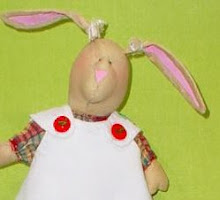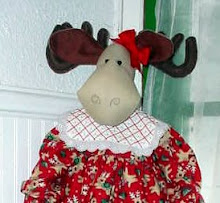Here's an article that I wrote for
Ezine Articles. I got into tea dying when I was trying to find the perfect color for Matilda.
How to Tea Dye:If you're looking for a little help on how to tea dye, you've come to the right place. But first - why tea dye?
Sometimes I wake up way before dawn and I want to make a doll or a Christmas ornament right NOW! I live at least 40 minutes from the closest fabric store and they're not even open yet. While I might not always have commercially tea dyed muslin on hand to make my bunnies and
reindeers, I always have yards and yards of the regular bleached and unbleached muslin that I can convert to the perfect color with tea dye.
Other Reasons to Tea Dye:
1. It's an easy and inexpensive way to mute down fabrics that look too bright or too new.
2. It's a way of bringing together unrelated fabrics.
3. It's a way to make any fabric look older or more antique.
4. It can mask minor stains.
5. The tea dye process is more forgiving than mordant dying, although not as predictable.
6. The tea dye is non-toxic.
7. It doesn't irritate skin.
8. It can be done in stages: dye it, dry it and if you're not happy with the result, dye it again or bleach it out.
Tea Dye Quirks:
1. Tea dye only works on natural fibers such as cotton, silk, linen, wool. It should also work on satin (woven from silk) and rayon. I have never tried it on rayon, but in general, rayon takes dyes very well.
2. It can be difficult to get large pieces of fabric to tea dye evenly. But personally, I like the subtle mottled look and sometimes the uneven coloration is perfect for the project at hand.
3. Tea-dying will NOT take a white fabric to off white, eggshell or ecru. It is a color all its own -- a shade of rusty brown - although it can be very light.
4. One lovely trait of tea dying is that if you're not happy with the color, you can let it sit longer (for darker and more intense results) or you can mix a little bleach in the rinse water to lighten or remove the color.
5. Once the tea dye is set, it is semi permanent. That means that the color won't wash out easily, but it may come out when washed with a bit of bleach or an "
oxy-clean" type product. While I wouldn't use tea dye for t-shirts or other clothing that will get washed frequently, it's perfect for the tenderly treated items like dolls and quilts.
6. Don't confuse tea-dying with tea staining. Tea dying is when an item will be submersed in a tea dye bath. Tea staining is done by applying the tea dye with a rag or paint brush.
7. Tea dyed fabric will dry lighter than it appears when wet.
8.Matching one batch of tea dyed muslin to another is almost impossible. Make sure you do enough yardage to complete your project.
Tea Dying Instructions:
1)First, gather the materials needed:
*Natural fibered fabric or items (gloves, lace, floss)
*Tea bags (orange pekoe or black pekoe. Use the cheapest bag tea that you can find)
* Boiling water
* Glass or stainless steel container
2)It's a good habit to start any dying project by washing the item/yardage with a mild detergent and rinsing it in cool water. This ensures that the sizing is washed out and won't inhibit the item from taking on the dye as evenly as possible. Let it sit in the cool water as you make the tea dying mixture.
3) Start by boiling water. A general rule of thumb is 4 cups of water for 1 yard of fabric. When the water boils, remove from the heat. Add 2 tea bags for every 8 ounces of water. So for 4 cups of water, you'll need eight tea bags. That will make enough tea dye to tint one yard of fabric.
Let the tea bags soak for 5 minutes. DO NOT ADD THE FABRIC YET.
4) After the steeping, your tea dye concoction should be a very dark reddish brown. Pull out the tea bags. Depending on the quality of the bag, you can gently squeeze it to get out the last bit of tea, but be careful the bag doesn't break and drop bits of soggy leaves into your tea bath.
5) Take the wet yardage and gently squeeze out the excess. You don't want to add so much water that it dilutes the tea dye. Submerge it into the tea. For a more even dying, gently swish and swirl your fabric periodically. However, if you want your fabric to take the dye unevenly for a more interesting look, just leave it creased and wadded.
6) When you think your fabric is dark enough, remove it from the tea dye mixture and rinse in cool water. During the rinsing process, a lot of the color will flush out. The lovely thing about tea dying is that you can go ahead and drop it back in to the dye if you want it darker.
7) There are two ways to set the color. #1. Fill another container with fresh water. Make sure the container is big enough to hold your tea dyed fabric. For every gallon of water, add ½ cup of white vinegar. Let your fabric sit in this mix for about 15 minutes. Then rinse the fabric and press it dry. #2. When you achieve the color you want, toss the fabric in the dryer set on its highest setting. When it's almost dry, remove it and smooth it out with an iron set at the hottest temperature the fabric can handle.
There is only one caveat that I've ever heard about tea dying: The pronounced amount of tannin in the tea dye can compromise the fibers of the fabric and it will rot away. The tannin will supposedly cut the longevity of the fabric to 30-40 years.
I hope you will try your hand at tea dying. And once you have your fabric dyed, pressed and ready to sew, go to
http://www.missbeesdesigns.com for a pattern that I designed specifically for tea dyed fabric.






